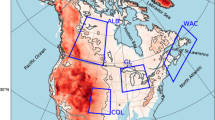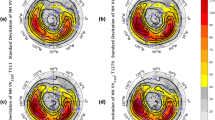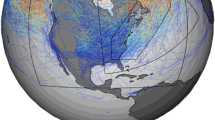Abstract
There are large uncertainties in the circulation response of the atmosphere to climate change. One manifestation of this is the substantial spread in projections for the extratropical storm tracks made by different state-of-the-art climate models. In this study we perform a series of sensitivity experiments, with the atmosphere component of a single climate model, in order to identify the causes of the differences between storm track responses in different models. In particular, the Northern Hemisphere wintertime storm tracks in the CMIP3 multi-model ensemble are considered. A number of potential physical drivers of storm track change are identified and their influence on the storm tracks is assessed. The experimental design aims to perturb the different physical drivers independently, by magnitudes representative of the range of values present in the CMIP3 model runs, and this is achieved via perturbations to the sea surface temperature and the sea-ice concentration forcing fields. We ask the question: can the spread of projections for the extratropical storm tracks present in the CMIP3 models be accounted for in a simple way by any of the identified drivers? The results suggest that, whilst the changes in the upper-tropospheric equator-to-pole temperature difference have an influence on the storm track response to climate change, the large spread of projections for the extratropical storm track present in the northern North Atlantic in particular is more strongly associated with changes in the lower-tropospheric equator-to-pole temperature difference.







Similar content being viewed by others
References
Barnes EA, Polvani L (2013) Response of the midlatitude jets, and of their variability, to increased greenhouse gases in the CMIP5 models. J Clim 26:7117–7135
Brayshaw DJ, Hoskins B, Blackburn M (2011) The basic ingredients of the North Atlantic storm track. Part II: sea surface temperatures. J Atmos Sci 68:1784–1805
Brayshaw DJ, Woollings T, Vellinga M (2009) Tropical and extratropical responses of the North Atlantic atmospheric circulation to a sustained weakening of the MOC. J Clim 22:3146–3155
Butler AH, Thompson DWJ, Heikes R (2010) The steady-state atmospheric circulation response to climate change-like thermal forcings in a simple general circulation model. J Clim 23:3474–3496
Chang EKM (2009) Are band-pass variance statistics useful measures of storm track activity? Re-examining storm track variability associated with the NAO using multiple storm track measures. Clim Dyn 33:277–296
Chen G, Lu J, Frierson DMW (2008) Phase speed spectra and the latitude of surface westerlies: interannual variability and global warming trend. J Clim 21:5942–5959
Chen G, Lu J, Sun L (2013) Delineating the eddy-zonal flow interaction in the atmospheric circulation response to climate forcing: uniform SST warming in an idealized aquaplanet model. J Atmos Sci 70:2214–2233
Deser C, Walsh JE, Timlin MS (2000) Arctic sea ice variability in the context of recent atmospheric circulation trends. J Clim 13:617–633
Drijfhout S, van Oldenburgh GV, Cimatoribus A (2012) Is a decline of AMOC causing the warming hole above the north atlantic in observed and modeled warming patterns? J Clim 25:8373–8379
Frierson DMW (2006) Robust increases in midlatitude static stability in simulations of global warming. Geophys Res Lett 33:L24,816
Graff LS, LaCasce JH (2012) Changes in the extratropical storm tracks in response to changes in SST in an AGCM. J Clim 25:1854–1870
Hartmann DL, Wallace JM, Limpasuvan V, Thompson DWJ, Holton JR (2000) Can ozone depletion and global warming interact to produce rapid climate change? Proc Natl Acad Sci 97:1412–1417
Harvey BJ, Shaffrey LC, Woollings TJ. (2013) Equator-to-pole temperature differences and the extra-tropical storm track responses of the CMIP5 climate models. Clim Dyn 43:1–12
Harvey BJ, Shaffrey LC, Woollings TJ, Zappa G, Hodges KI (2012) How large are projected 21st century storm track changes? Geophys Res Lett 39:L052,873
Hoskins BJ, Hodges KI (2002) New perspectives on the Northern Hemisphere winter storm tracks. J Atmos Sci 59:1041–1061
Johns TC, Durman CF, Banks HT, Roberts MJ, McLaren AJ, Ridley JK, Senior CA, Williams KD, Jones A, Rickard GJ et al (2006) The new Hadley Centre climate model (HadGEM1): evaluation of coupled simulations. J Clim 19:1327–1353
Kidston J, Vallis GK, Dean SM, Renwick JA (2011) Can the increase in the eddy length scale under global warming cause the poleward shift of the jet streams? J Clim 24:3764–3780
Kodama C, Iwasaki T (2009) Influence of the SST rise on baroclinic instability wave activity under an aquaplanet condition. J Atmos Sci 66:2272–2287
Laîné A, Kageyama M, Salas-Mélia D, Ramstein G, Planton S, Denvil S, Tyteca S (2009) An energetics study of wintertime Northern Hemisphere storm tracks under 4 × CO2 conditions in two ocean-atmosphere coupled models. J Clim 22:819–839
Lorenz DJ, DeWeaver ET. (2007) Tropopause height and zonal wind response to global warming in the IPCC scenario integrations. J Geophys Res Atmos 112
Magnusdottir G, Deser C, Saravanan R (2004) The effects of North Atlantic SST and sea ice anomalies on the winter circulation in CCM3. Part I: main features and storm track characteristics of the response. J Clim 17:857–876
Martin GM, Ringer MA, Pope VD, Jones A, Dearden C, Hinton TJ (2006) The physical properties of the atmosphere in the new Hadley Centre Global Environmental Model (HadGEM1). Part I: Model description and global climatology. J Clim 19:1274–1301
Rivière G (2011) A dynamical interpretation of the poleward shift of the jet streams in global warming scenarios. J Atmos Sci 68:1253–1272
Scaife ATS, DR Fereday, Cubasch U, Langematz U, Akiyoshi H, Bekki S, Braesicke P, Butchart N, Chipperfield MP et al (2012) Climate change projections and stratosphere–troposphere interactions. Clim Dyn 38:2089–2097
Schneider T, O’Gorman PA, Levine XJ (2010) Water vapor and the dynamics of climate changes. Rev Geophys 48:RG3001
Screen JA, Deser C, Simmonds I (2012) Local and remote controls on observed Arctic warming. Geophys Res Lett 39:L10,709
Solomon S, Qin D, Manning M, Chen Z, Marquis M, Averyt K, Tignor M, Miller H (eds) (2007) IPCC, 2007: climate change 2007: the physical science basis. In: Contribution of working group I to the fourth assessment report of the intergovernmental panel on climate change. Cambridge University Press, Cambridge
Stroeve J, Holland MM, Meier W, Scambos T, Serreze M (2007) Arctic sea ice decline: faster than forecast. Geophys Res Lett 34
Ulbrich U, Pinto J, Kupfer H, Leckebusch G, Spangehl T, Reyers M (2008) Changing northern hemisphere storm tracks in an ensemble of IPCC climate change simulations. J Clim 21:1669–1679
Williams GP (2006) Circulation sensitivity to tropopause height. J Atmos Sci 63
Wilson C, Sinha B, Williams RG (2009) The effect of ocean dynamics and orography on atmospheric storm tracks. J Clim 22:3689–3702
Woollings T, Blackburn M (2012) The North Atlantic jet stream under climate change and its relation to the NAO and EA patterns. J Clim 25:886–902
Woollings T, Gregory JM, Pinto JG, Reyers M, Brayshaw DJ (2012) Response of the North Atlantic storm track to climate change shaped by ocean-atmosphere coupling. Nat Geosci 5:313–317
Yin JH (2005) A consistent poleward shift of the storm tracks in simulations of 21st century climate. Geophys Res Lett 32:L18,701
Zappa G, Shaffrey LC, Hodges KI (2013a) The ability of CMIP5 models to simulate north Atlantic extratropical cyclones. J Clim 26:5379–5396
Zappa G, Shaffrey LC, Hodges KI, Sansom PG, Stephenson DB (2013b) A multimodel assessment of future projections of North Atlantic and European Extratropical Cyclones in the CMIP5 climate models. J Clim 26:5846–5862
Acknowledgments
BJH was supported by the Natural Environment Research Councils Project Testing and Evaluating Model Predictions of European Storms (TEMPEST) during the course of this work. The authors acknowledge the World Climate Research Programme’s Working Group on Coupled Modelling, which is responsible for CMIP, and we thank the climate modeling groups for producing and making available their model output. For CMIP the U.S. Department of Energy’s Program for Climate Model Diagnosis and Intercomparison provides coordinating support and led development of software infrastructure in partnership with the Global Organization for Earth System Science Portals.
Author information
Authors and Affiliations
Corresponding author
Appendices
Appendix 1: List of CMIP3 models used in this study
Data from the following 21 models are used in this study. One run per model is used, and this is the run denoted ‘run1’ in almost all cases. It is noted in the main text if particular fields are unavailable for any of the models.
BCCR-BCM2.0 (Bjerknes Centre for Climate Research), CGCM3.1(T47) and CGCM3.1(T63) (Canadian Centre for Climate Modelling & Analysis), CNRM-CM3 (Mètèo-France/Centre National de Recherches Mètèorologiques), CSIRO-Mk3.0 and CSIRO-Mk3.5 (CSIRO Atmospheric Research), ECHAM5/MPI-OM (Max Planck Institute for Meteorology), ECHO-G (Meteorological Institute of the University of Bonn, Meteorological Research Institute of KMA, and Model and Data group), GFDL-CM2.0 and GFDL-CM2.1 (US Dept. of Commerce/NOAA/Geophysical Fluid Dynamics Laboratory), GISS-AOM and GISS-ER (NASA/Goddard Institute for Space Studies), INGV-SXG (Instituto Nazionale di Geofisica e Vulcanologia), INM-CM3.0 (Institute for Numerical Mathematics), IPSL-CM4 (Institut Pierre Simon Laplace), MIROC3.2(hires) and MIROC3.2(medres) [Center for Climate System Research (The University of Tokyo), National Institute for Environmental Studies, and Frontier Research Center for Global Change (JAMSTEC)], MRI-CGCM2.3.2 (Meteorological Research Institute), NCAR CCSM3 (National Center for Atmospheric Research), UKMO-HadCM3 and UKMO-HadGEM1 (Hadley Centre for Climate Prediction and Research/Met Office).
Appendix 2: Design of the sea-ice concentration fields
As noted in Sect. 2.2, due to the large range of 20C3M ice extents in the CMIP3 models (Stroeve et al. 2007), simply taking the multi-model mean of the SIC values (as was done for the SSTs) produces an ice distribution with an unrealistically smooth ice edge region. To avoid this problem artificial SIC distributions have been created to mimic the typical ice distribution of the CMIP3 models, whilst retaining a realistic ice-edge structure. Here we describe the algorithm for constructing these SIC fields.
Four ice distributions are used in this study, one representing the 20C3M ice distribution (used in CON-20C), one representing the mean SRESA1B response (used in CON-A1B), and two capturing the spread of the responses between the models (used in ARC±). For each month of the CON-20C experiment, a multi-model mean ice edge position is defined as the 50 % contour of the multi-model mean SIC distribution. The artificial SIC distribution is then constructed to equal 100 % poleward of this ice edge, linearly reducing over a distance of 5° to 0 % equatorward of the ice edge. The width of this ice edge region was chosen by a consideration of typical ice edge regions in the CMIP3 20C3M wintertime ice distributions.
The remaining three ice distributions are then constructed by retreating the ice edge in CON-20C towards the pole. The distance retreated, a function of longitudinal grid point, is first calculated separately for each CMIP3 model. The distances retreated for CON-A1B, ARC+ and ARC− are then taken as the median and standard deviation of the retreats in the models. This process is illustrated in Fig. 8 which shows, for the January values, the number of degrees latitude retreated by each the ice edge in each model. Also shown, in the lower panel, is the resulting ice edge positions of the four ice distributions. Once the position of the ice edge is found, artificial SIC distributions are then constructed, as above, to equal 100 % poleward of this ice edge, linearly reducing over a distance of 5° to 0 % equatorward of the ice edge.
The large panel shows the distance of ice edge retreat, as a function of longitude, for the monthly-mean January ice distributions of each CMIP3 model. The retreat is defined as the difference in ice edge position between years 1961–2000 from 20C3M and years 2061–2100 from SRESA1B and is measured in units of degrees of latitude. The models are ordered by the total area of monthly mean January ice in the 20C3M period, as indicated on the left-side axis; also indicated (right-side axis) is the change in January ice area between the 20C3M and SRESA1B periods. The lower panel indicates the constructed January ice edge positions for the CON-20C, CON-A1B, ARC− and ARC+ experiments, as indicated
Rights and permissions
About this article
Cite this article
Harvey, B.J., Shaffrey, L.C. & Woollings, T.J. Deconstructing the climate change response of the Northern Hemisphere wintertime storm tracks. Clim Dyn 45, 2847–2860 (2015). https://doi.org/10.1007/s00382-015-2510-8
Received:
Accepted:
Published:
Issue Date:
DOI: https://doi.org/10.1007/s00382-015-2510-8





